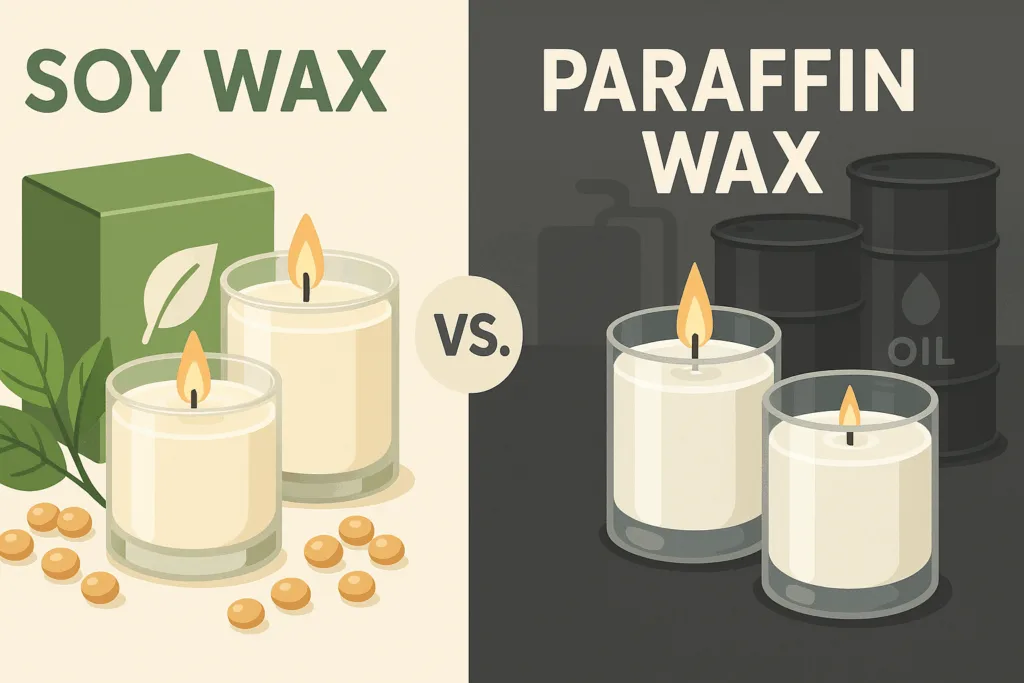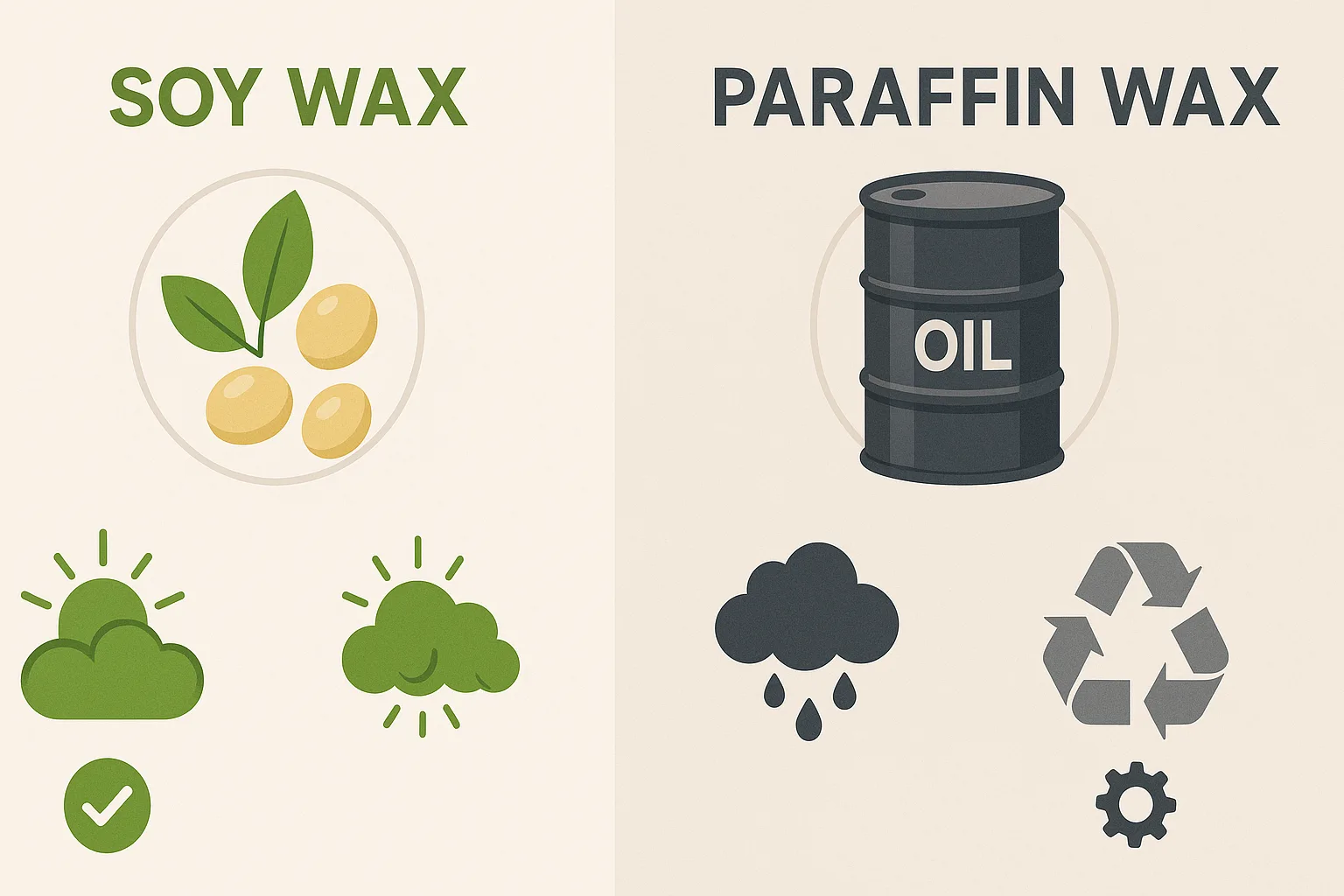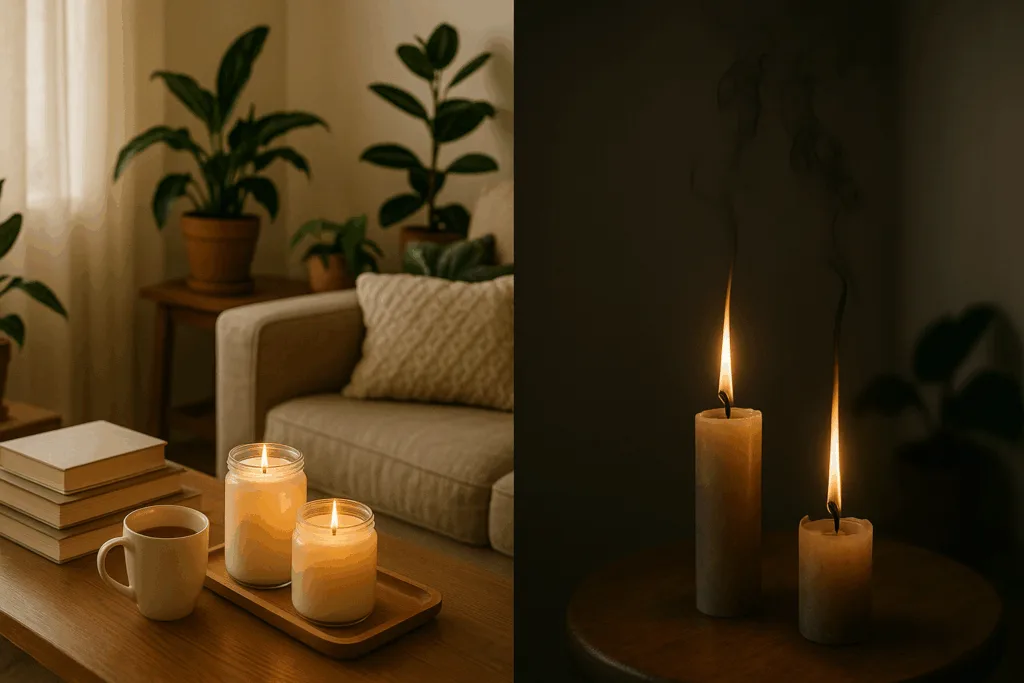1. A Brief History of Candles and Wax Materials
Candles have been a part of human life for thousands of years. In ancient times, people relied on beeswax, tallow, and other natural fats to produce light. As technology advanced, the 19th century brought the widespread use of paraffin wax, a petroleum byproduct that was cheap, easy to produce, and widely available. Paraffin candles quickly became popular because of their low cost and stable burning properties.
However, as consumer awareness about health and sustainability has grown, people began looking for healthier and eco-friendly alternatives. This shift led to the rise of soy wax in the 1990s, a renewable option made from soybean oil. Today, the debate between soy wax vs paraffin wax is at the heart of the candle industry. Consumers want to know: which is better for health, the environment, and overall lifestyle?
2. What is Paraffin Wax?
Paraffin wax is a byproduct of petroleum refining. It is extracted from crude oil during the oil purification process, then filtered and processed into the solid wax commonly used in candles. Paraffin wax is:
- Inexpensive: It is cheap to produce, making it widely used in mass-market candles.
- Consistent: It burns evenly and allows for strong fragrance throw.
- Color-Friendly: Easily dyed, making it popular in decorative candles.
Despite these benefits, paraffin wax has raised concerns due to its petroleum origins. When burned, paraffin can release chemicals such as benzene and toluene, both linked to health issues when inhaled over time. While regulatory bodies argue that small amounts are generally safe, health-conscious consumers are increasingly cautious.
3. What is Soy Wax?
Soy wax is made from hydrogenated soybean oil. It was first developed in the 1990s as an eco-friendly alternative to paraffin. Soy wax is now one of the most popular natural waxes used in candle making, especially for premium and artisan candles.
Key Characteristics of Soy Wax
- Natural and renewable: Made from soybeans, which are widely grown and sustainable.
- Cleaner burning: Produces minimal soot compared to paraffin.
- Longer burn time: Burns at a cooler temperature, making candles last longer.
- Better health profile: Free from petroleum byproducts, suitable for homes with children and pets.
Soy wax aligns with the growing trend toward eco-conscious living and is often preferred by people who want a natural, non-toxic candle experience.
4. Chemical Composition: Soy vs Paraffin
The differences between soy and paraffin wax begin at the molecular level:
| Feature | Soy Wax | Paraffin Wax |
|---|---|---|
| Source | Plant-based (soybean oil) | Petroleum-based (crude oil byproduct) |
| Burning | Cooler, cleaner | Hotter, may release toxins |
| Soot Production | Minimal | Higher, especially with poor wick maintenance |
| Biodegradable | Yes | No |
Soy wax consists mainly of triglycerides (fats derived from natural oils), while paraffin consists of long-chain hydrocarbons. These differences explain why soy burns cleaner and is biodegradable, while paraffin, though efficient, is less environmentally friendly.
5. Health Concerns of Paraffin Wax Candles
Paraffin wax candles are popular, but their health implications cannot be ignored. Studies suggest that burning paraffin candles may release small amounts of harmful compounds:
- Benzene and Toluene: Known carcinogens when inhaled in large amounts.
- Soot Particles: Can contribute to poor indoor air quality and respiratory irritation.
- Allergic Reactions: Some sensitive individuals may experience headaches, asthma flare-ups, or allergy-like symptoms.
While occasional use of paraffin candles may not cause major health problems, frequent use in poorly ventilated spaces may contribute to long-term exposure risks.
6. Health Benefits of Soy Wax Candles
Soy wax candles offer multiple health benefits compared to paraffin:
- Non-toxic burning: They do not release harmful petrochemicals.
- Low soot emission: Helps keep indoor air cleaner.
- Hypoallergenic: Safe for children, pets, and sensitive individuals.
- Better essential oil diffusion: Works well with aromatherapy for stress relief and relaxation.
Soy candles align with holistic wellness trends, making them popular among those who value clean air and a healthier lifestyle.
7. Environmental Impact: Renewable vs Non-renewable
From an environmental perspective, soy wax is significantly more sustainable:
- Soy Wax: Renewable resource, biodegradable, and reduces carbon footprint.
- Paraffin Wax: Derived from non-renewable fossil fuels, contributing to carbon emissions.
Moreover, soy wax production supports the agricultural industry, whereas paraffin relies on the oil industry. For eco-conscious consumers, the choice is clear: soy wax supports a greener planet.
8. Burn Time and Performance Comparison
When comparing performance:
- Soy Wax Candles: Burn 30–50% longer than paraffin due to cooler temperatures.
- Paraffin Candles: Stronger scent throw but shorter burn time.
This means soy candles may initially cost more, but they last longer, providing better value in the long run. Soy wax also creates a more consistent and softer scent release, ideal for aromatherapy.
9. Cost and Market Availability
Paraffin remains the cheaper option due to mass production. Soy wax is more expensive because of:
- Higher raw material costs.
- Handcrafted production in premium candle lines.
- Focus on sustainability.
However, consumer demand is shifting. Market reports show steady growth in natural and organic candles as more people prioritize health and eco-friendly living.
10. Candle Aesthetics and Craftsmanship
Aesthetic appeal also differs:
- Paraffin Candles: Offer bright colors, intricate designs, and sharp finishes.
- Soy Wax Candles: More natural look with creamy textures, often paired with minimalist packaging.
Luxury brands like Circe Home emphasize soy wax because it aligns with artisanal craftsmanship, eco-luxury design, and health-conscious branding.
11. Which Wax is Better for Aromatherapy?
Aromatherapy relies on clean-burning candles that carry essential oils effectively. Soy wax is superior in this regard:
- Soy Wax: Burns cooler, preserving the integrity of essential oils.
- Paraffin Wax: Burns hotter, sometimes diminishing natural aromas.
This makes soy the preferred choice for therapeutic candles aimed at stress relief, meditation, or yoga.
12. Candle Safety Tips for Both Soy and Paraffin
Regardless of wax type, safe usage is essential:
- Trim the wick to 1/4 inch before each burn.
- Never leave a candle unattended.
- Burn in well-ventilated areas.
- Avoid drafts to reduce soot production.
- Use proper candle holders to prevent accidents.
By following safety tips, you can minimize health risks even when burning paraffin candles.
13. How to Identify Pure Soy Wax Candles
Not all candles labeled “soy” are 100% soy wax. Many are soy blends mixed with paraffin. To ensure you are buying pure soy:
- Check labels for “100% Soy Wax.”
- Look for eco-certifications.
- Buy from trusted brands like Circe Home that prioritize transparency.
- Avoid candles with overly glossy finishes, which may indicate paraffin blends.
14. Circe Home’s Commitment to Healthier Candles
At Circe Home, we believe that candles should enhance wellness, not compromise it. Our commitment includes:
- 100% natural soy wax.
- Lead-free cotton wicks.
- Pure essential oils for fragrance.
- Eco-friendly packaging.
We strive to create candles that not only fill your home with beautiful scents but also support your health and the planet.
15. Consumer Choice: When to Pick Soy, When to Pick Paraffin
While soy is the healthier and more sustainable choice, paraffin may still be suitable for:
- Decorative purposes where strong color and design are desired.
- Short-term use during events.
Soy candles, on the other hand, are ideal for:
- Daily burning.
- Aromatherapy sessions.
- Health-conscious households.
16. Expert Opinions and Scientific Research
Multiple studies support soy wax as a safer alternative. For example, the U.S. Environmental Protection Agency (EPA) has highlighted concerns about indoor air pollutants from paraffin candles. Meanwhile, soy wax has been shown to produce fewer pollutants and is widely considered a healthier option by wellness experts.
17. Final Verdict: Which Wax Wins the Healthier Candle Debate?
After reviewing history, health, environment, and performance, the conclusion is clear: soy wax is the healthier, more sustainable choice. While paraffin remains affordable and widely used, its petroleum origins and potential toxins make it less appealing for modern, health-conscious lifestyles.
Circe Home proudly champions soy wax as the future of clean, beautiful, and eco-friendly candle making.
FAQ: Common Questions About Soy and Paraffin Candles
Q1: Do soy candles really last longer than paraffin candles?
Yes, soy candles typically burn 30–50% longer than paraffin candles due to their lower melting point.
Q2: Are paraffin candles dangerous to use indoors?
Not necessarily, but frequent use in poorly ventilated spaces can increase exposure to soot and toxins.
Q3: Can soy candles trigger allergies?
Soy candles are generally hypoallergenic and safer for sensitive individuals, children, and pets.
Q4: Why are soy candles more expensive?
They are made from renewable plant-based oils, often hand-poured, and emphasize eco-friendly production.
Q5: How can I tell if a candle is paraffin-free?
Look for labels stating “100% Soy Wax” and avoid candles that simply say “soy blend.”
Q6: Do soy candles hold fragrance as well as paraffin candles?
Yes, though soy candles release scents more subtly and evenly, making them ideal for relaxation and aromatherapy.
Conclusion
Both soy and paraffin candles have their place, but soy stands out as the healthier, cleaner, and more sustainable choice. For those who want candles that elevate wellness and protect the environment, soy wax is the clear winner.





